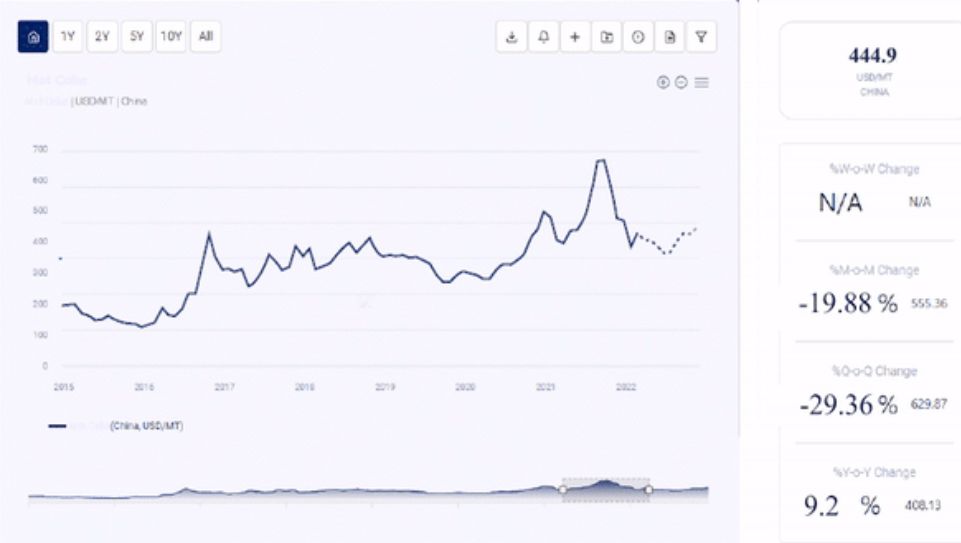In this comprehensive press release, we delve into the price movements and trend analysis of dehydrated garlic across various global regions, including Asia, Europe, North America, Latin America, and the Middle East & Africa. We will explore the definition of dehydrated garlic, key details about its price trends, the industrial uses impacting these trends, and the key players in the market. This analysis aims to provide valuable insights for stakeholders looking to understand and navigate the global dehydrated garlic market.
Request For Free Sample: https://www.procurementresource.com/resource-center/dehydrated-garlic-domestic-price-trends/pricerequest
Definition
Dehydrated garlic, a widely used culinary and medicinal ingredient, is garlic that has been processed to remove its moisture content while retaining its essential flavor and properties. The dehydration process involves cleaning, slicing, and drying fresh garlic cloves using various methods such as air drying, freeze drying, or spray drying. The result is a product that can be stored for extended periods without spoilage, making it a convenient and cost-effective alternative to fresh garlic.
Dehydrated garlic is available in several forms, including granules, powder, flakes, and minced. Each form has specific applications in different industries, from food processing and culinary arts to pharmaceuticals and animal feed. The versatility and long shelf life of dehydrated garlic have contributed to its growing demand and significant role in global trade.
Key Details About the Dehydrated Garlic Price Trend
The price of dehydrated garlic is influenced by a multitude of factors, including agricultural production, weather conditions, supply chain dynamics, and global demand. Here, we analyze the recent trends and fluctuations in dehydrated garlic prices across different regions.
- Asia: Asia, particularly China and India, is a major producer and exporter of dehydrated garlic. The prices in this region are largely affected by domestic production levels and export demand. In recent years, China’s large-scale garlic cultivation and processing capabilities have positioned it as a dominant player in the market. However, factors such as labor costs, environmental regulations, and changes in crop yield due to climatic conditions can cause price variability.
- Europe: Europe imports significant quantities of dehydrated garlic, with Spain being one of the notable producers within the region. The prices in Europe are influenced by import tariffs, trade policies, and the region’s demand for high-quality food ingredients. The trend towards organic and clean-label products has also impacted the price, with organic dehydrated garlic commanding a premium.
- North America: In North America, the United States is both a producer and importer of dehydrated garlic. The price trends here are shaped by domestic agricultural policies, import duties, and consumer preferences for convenience foods. The increasing use of dehydrated garlic in processed foods, ready-to-eat meals, and health supplements has driven demand, influencing price movements.
- Latin America: Latin American countries, including Mexico and Argentina, are emerging as important players in the dehydrated garlic market. The prices in this region are influenced by agricultural production capacity, trade agreements, and regional consumption patterns. Latin America’s strategic location also facilitates trade with North America, impacting price trends.
- Middle East & Africa: The Middle East and Africa import dehydrated garlic to meet their culinary and industrial needs. Price trends in this region are affected by import tariffs, logistical challenges, and currency exchange rates. The growing popularity of international cuisines and processed foods has increased demand for dehydrated garlic, impacting its price.
Industrial Uses Impacting the Dehydrated Garlic Price Trend
Dehydrated garlic’s versatility makes it a valuable ingredient across various industries. Here are some of the key industrial uses that impact its price trends:
- Food and Beverage Industry: Dehydrated garlic is extensively used in the food and beverage industry as a flavoring agent. It is a staple ingredient in seasonings, sauces, soups, snacks, and ready-to-eat meals. The demand from this industry significantly influences the price of dehydrated garlic. Changes in consumer preferences, such as the shift towards organic and natural products, also impact the price dynamics.
- Pharmaceuticals: The medicinal properties of garlic, particularly its antibacterial and anti-inflammatory effects, make dehydrated garlic a valuable component in pharmaceuticals and nutraceuticals. The demand for health supplements and natural remedies contributes to the price fluctuations of dehydrated garlic.
- Animal Feed: Dehydrated garlic is used in animal feed for its health benefits, including improved digestion and enhanced immune function in livestock. The agricultural sector’s demand for dehydrated garlic as a feed additive can influence its price, particularly in regions with large-scale livestock farming.
- Cosmetics and Personal Care: The cosmetic industry utilizes dehydrated garlic in skincare products due to its antioxidant properties. The growing trend of natural and organic cosmetics has increased the demand for dehydrated garlic, affecting its market price.
- Agriculture: Dehydrated garlic is used in organic farming as a natural pesticide and soil conditioner. The agricultural sector’s adoption of sustainable practices and organic farming methods drives demand for dehydrated garlic, impacting its price.
Key Players
The global dehydrated garlic market is competitive, with several key players contributing to production, processing, and distribution. These companies play a crucial role in shaping the market dynamics and price trends. Some of the prominent players in the dehydrated garlic market include:
- Garlico Industries Ltd.: Based in India, Garlico Industries is a leading producer and exporter of dehydrated garlic products. The company focuses on quality and innovation to meet the diverse needs of its global clientele.
- Jiangsu Dingneng Food Co., Ltd.: A major player in China, Jiangsu Dingneng Food specializes in the production and export of dehydrated garlic. The company’s advanced processing facilities and stringent quality control measures ensure high-quality products.
- V.T. Foods Pvt. Ltd.: Another key player from India, V.T. Foods offers a wide range of dehydrated garlic products. The company emphasizes sustainable sourcing and processing practices to deliver premium products to international markets.
- Garlic King: Based in the United States, Garlic King is known for its high-quality dehydrated garlic products. The company’s focus on innovation and customer satisfaction has established it as a reputable name in the industry.
- B.C. Foods, Inc.: A global supplier of dehydrated garlic and other food ingredients, B.C. Foods operates multiple processing facilities worldwide. The company’s extensive product portfolio and commitment to quality make it a key player in the market.
Conclusion
The dehydrated garlic market is dynamic, with prices influenced by a myriad of factors including production levels, global demand, and industrial applications. As the market continues to evolve, understanding these price trends and the forces driving them is essential for stakeholders across the supply chain.
Contact Us:
Company Name: Procurement Resource
Contact Person: Christeen Johnson
Email: [email protected]
Toll-Free Number: USA & Canada – Phone no: +1 307 363 1045 | UK – Phone no: +44 7537 132103 | Asia-Pacific (APAC) – Phone no: +91 1203185500
Address: 30 North Gould Street, Sheridan, WY 82801, USA










